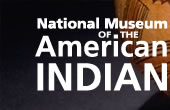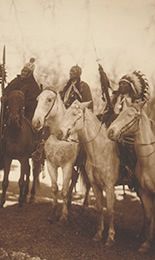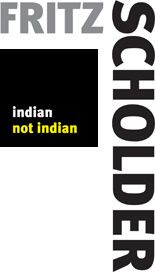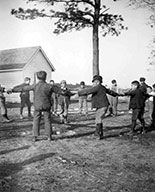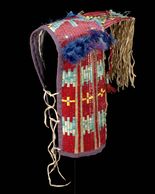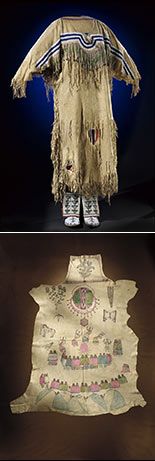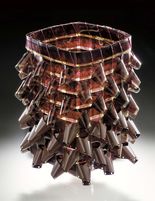|
|
Fritz Scholder: Indian/Not Indian
November 1, 2008–August 16, 2009 NMAI on the National Mall, Washington, DC This comprehensive two-city exhibition illuminates the achievements of one of the most influential American artists of the 20th century, the late Fritz Scholder (1937–2005). |
|||
|
Return to a Native Place: Algonquian Peoples of the Chesapeake
Ongoing NMAI on the National Mall, Washington, DC Meet the Native peoples of the Chesapeake Bay region–what is now Washington, D.C., Maryland, Virginia, and Delaware–through photographs, maps, ceremonial and everyday objects, and interactives. This compact exhibition educates visitors on the continued Native presence in the region, and provides an overview of the history and events from the 1600s to the present that have impacted the lives of the Nanticoke, Powhatan, and Piscataway tribes. The exhibition was curated by Gabrielle Tayac, Ph.D. (Piscataway). Nanticoke schoolboys playing "bear in ring," Delaware, ca. 1911. Boy facing the camera is Roosevelt Perkins. Photo by Frank G. Speck. N01304
|
|||
|
Our Universes: Traditional Knowledge Shapes Our World
Ongoing NMAI on the National Mall, Washington, DC Our Universes focuses on indigenous cosmologies—worldviews and philosophies related to the creation and order of the universe—and the spiritual relationship between humankind and the natural world. Organized around the solar year, the exhibition introduces visitors to indigenous peoples from across the Western Hemisphere who continue to express the wisdom of their ancestors in celebration, language, art, spirituality, and daily life. The community galleries feature eight cultural philosophies—those of the Pueblo of Santa Clara (Espanola, New Mexico, USA), Anishinaabe (Hollow Water and Sagkeeng Bands, Manitoba, Canada), Lakota (Pine Ridge Reservation, South Dakota, USA), Quechua (Communidad de Phaqchanta, Cusco, Peru), Hupa (Hoopa Valley, California, USA), Q'eq'chi' Maya (Cobán, Guatemala), Mapuche (Temuco, Chile), and Yup'ik (Yukon-Kuskokwim Delta, Alaska, USA). The design of these galleries reflects each community's interpretation of the order of the world.The exhibition also highlights the Denver (Colorado) March Powwow, the North American Indigenous Games, and the Day of the Dead as seasonal celebrations that bring Native peoples together. Lakota model baby carrier with porcupine-quill embroidery, North or South Dakota, ca. 1880. 12/2308. Photo by Walter Larrimore, NMAI.
|
|||
|
Our Peoples: Giving Voice to Our Histories
Ongoing NMAI on the National Mall, Washington, DC Historically, Native people have been portrayed in textbooks in narrow or inaccurate ways. In Our Peoples, Native Americans tell their own stories—their own histories—and in this way the exhibition presents new insights into, and different perspectives on, history. The Seminole Tribe of Florida, Tapirapé (Mato Grosso, Brazil), Kiowa Tribe of Oklahoma (USA), Tohono O'odham Nation (Arizona, USA), Eastern Band of the Cherokee Nation (North Carolina, USA), Nahua (Guerrero, Mexico), Ka'apor (Maranhão, Brazil), and Wixaritari (Durango, Mexico)—sometimes known as Huichol—were the first communities and tribes to share their stories with visitors in the Our Peoples gallery. Two new tribal communities added their voices in 2007, when exhibitions representing the Blackfeet Nation (Browning, Montana) and Chiricahua Apache (Mescalero, New Mexico) were rotated into the gallery, replacing the Seminole and Tapirapé installations. The main story of Our Peoples focuses on the last 500 years of Native history and shows how the arrival of newcomers in the Western Hemisphere set the stage for one of the most momentous events in human history. In the struggle for survival, nearly every Native community wrestled with the impact of deadly new diseases and weaponry, the weakening of traditional spirituality, and the seizure of homelands by invading governments. But the story of these last five centuries is not entirely a story of destruction. It is also about how Native people intentionally and strategically kept their cultures alive. Blackfeet woman's beaded dress, ca. 1890. 13/2383; and Chiricahua Apache Gutálsi'á' (hide painting) representing the Na'ii'es, or puberty ceremony, made by Naiche, ca. 1900. 2/1417. Photos by Ernest Amoroso, NMAI.
|
|||
|
Our Lives: Contemporary Life and Identities
Ongoing NMAI on the National Mall, Washington, DC Our Lives reveals how residents of eight Native communities—the Campo Band of Kumeyaay Indians (California, USA), the urban Indian community of Chicago (Illinois, USA), Yakama Nation (Washington State, USA), Igloolik (Nunavut, Canada), Kahnawake (Quebec, Canada), Saint-Laurent Metis (Manitoba, Canada), Kalinago (Carib Territory, Dominica), and the Pamunkey Tribe (Virginia, USA)—live in the 21st century. Through their stories, visitors learn about the deliberate and often difficult choices indigenous people make in order to survive economically, save their languages from extinction, preserve their cultural integrity, and keep their traditional arts alive. The main section of Our Lives centers on various layers of identity. For Native people, identity—who you are, how you dress, what you think, where you fit in, and how you see yourself in the world—has been shaped by language, place, community membership, social and political consciousness, and customs and beliefs. But Native identity has also been influenced by a legacy of legal policies that have sought to determine who is Indian and who is not. The issue of Native identity continues to resonate today, as Native people across the Americas seek to claim the future on their own terms.Gail Tremblay (Onondaga/Mi'kmaq, b. 1945), Strawberry and Chocolate, 2000. 16mm film and fullcoat, height 229 cm. 25/7273. Photo by Ernest Amoroso, NMAI.
|
|||
